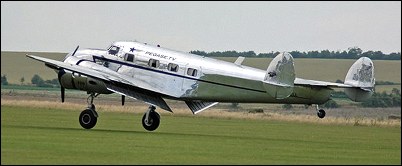|
| When the Lockheed 10 Electra first entered service, its 10-passenger capacity was considered to be too small for airline operators, but too large for operators of feederline services. To satisfy the latter demand, Lockheed decided to produce a reduced-scale version which would accommodate six passengers and a crew of two, and, by retaining the powerplant of its larger sister, offer enhanced performance. The resulting aircraft, designated Lockheed 12 Electra Junior, was flown for the first time on 27 June 1936 and, perhaps much to the surprise of the company, its sales success almost equalled that of the Lockheed 10, with a total of 130 built. The majority of production aircraft were designated Lockheed 12-A, but many of the total entered military service. The US Army Air Corps acquired three seven-seat C-40 (later UC-40), 10 five-seat C-40A (later UC-40A) and one experimental C-40B aircraft with fixed tricycle landing gear; the designation C-40D (later UC-40D) was allocated to 10 Lockheed 12-As impressed for wartime service. The US Navy received one seven-seat JO-1, five six-seat JO-2 aircraft (one of which was allocated for US Marine Corps use), and a single XJO-3 with fixed tricycle landing gear which was used for carrier deck-landing trials.
The type was used also by the air arms of Argentina, Canada, Cuba and the UK, as well as by the Netherlands East Indies army, this last service being the major military user with a total of 36. Of this number, 16 were specially-developed Model 212 crew trainers, with a forward-firing 7.7mm machine-gun, a similar weapon in a dorsal turret, and underfuselage racks for up to 363kg of bombs.
One of the most interesting aircraft was that acquired by NACA, predecessor of NASA, which was used to evaluate a wing de-icing system that utilised hot gases from the engine exhaust. One of the most unusual applications of the Lockheed 12-A was by Australian Sidney Cotton who, under the cover of his position as an executive of the Dufaycolour Company, used his specially modified camera-carrying Lockheed 12-A to take clandestine reconnaissance photographs of German military installations in the three months leading up to the beginning of World War II.
 | A three-view drawing (1280 x 870) |
| MODEL | Lockheed 12-A |
| ENGINE | 2 x Pratt & Whitney Wasp Junior SB radial piston engines, 336kW |
| Gary Gordon, e-mail, 29.11.2011 00:41 I left a comment in your section on the Lockheed 10 Electra but I was actually speaking about this a /c, the 12A Electra Junior reply | | Glenn Eckard, e-mail, 18.12.2010 02:09 Did the University of Virginia have one of these aircraft about 1958? reply | | tony, e-mail, 20.09.2009 18:16 Seen today, 20 Sept.09 over Goodwood West Sussex. reply |
|
Do you have any comments?
|
| 
COMPANY
PROFILE
All the World's Rotorcraft
|







